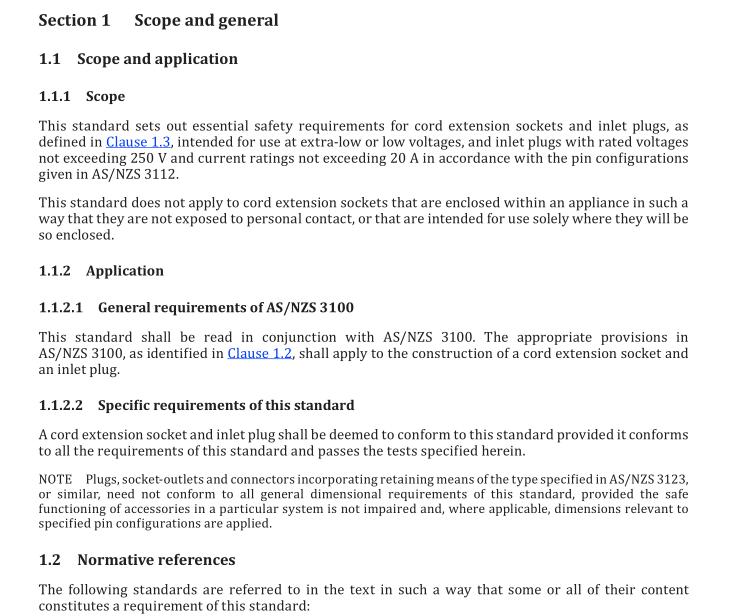AS NZS 3120 pdf download – Approval and test specification — Cord extension sockets

AS NZS 3120 pdf download – Approval and test specification — Cord extension sockets
2.1 General Cord extension sockets covered in this Section are intended for use with plugs conforming to AS/NZS 3112 and/or the corresponding inlet plugs conforming to this standard.
2.2 Exemptions for extra-low voltage sockets Extra-low voltage type sockets are not required to conform to the requirements for internal connections, prevention of contact with live pins and withdrawal force test.
2.3 Limitation of outlets Sockets shall accommodate one plug only.
2.4 Terminals and internal connections
2.4.1 Material Terminals and internal connections that are intended primarily for carrying current shall be of corrosion-resisting metal. Conformance shall be checked by inspection and, if necessary, by chemical analysis. NOTE Examples of conforming metals, when used within the permissible temperature range and under normal conditions of chemical pollution, are as follows:
(a) Copper.
(b) An alloy containing at least 58 % copper for parts that are worked cold or at least 50 % copper for other parts.
(c) Stainless steel containing at least 13 % chromium and not more than 0.09 % carbon. Terminals and internal connections that are intended primarily for carrying current shall conform to the mechanical strength requirements in AS/NZS 3100. Conformance shall be checked by the tests referenced in Section titled “Protection against mechanical and electrical failure” of AS/NZS 3100.
2.4.2 Construction of terminals The terminals shall be capable of accommodating the conductors of a flexible cord of current rating, corresponding to the marked current rating of the socket. Facilities shall be provided to prevent slipping or spreading of the conductors or conductor strands. Where the facilities are such that the conductor is to be located around the shank of the terminal screw and clamped under the screw head, the following shall apply:
(a) When the terminal screw is screwed in to the limit of its thread, the clearance between the head of the screw and the washer or means of retention of the conductor shall not exceed 0.4 mm.
(b) The length of the terminal screw shall enable it to be backed off from the washer or means of retention of the conductor so that the conductor may be located around the shank without difficulty.
(c) Where the means of retention of the conductor is not continuous (e.g. prongs), there shall be at least three points of retention and the maximum angle between any two points shall not exceed 150°.
(d) Where the means of retention of the conductor is continuous (e.g. a portion of the insulating moulding), the angle subtended by the arc of the means of retention shall be not less than 180°. When the socket is correctly assembled, the terminals shall be held firmly in position.
2.5 Contacts
2.5.1 Material Contacts shall be of corrosion-resisting metal. Conformance shall be checked by inspection and, if necessary, by chemical analysis. NOTE Examples of conforming metals, when used within the permissible temperature range and under normal conditions of chemical pollution, are as follows:
(a) Copper.
(b) An alloy containing at least 58 % copper for parts that are worked cold or at least 50 % copper for other parts.
(c) Stainless steel containing at least 13 % chromium and not more than 0.09 % carbon. Contacts shall conform to the mechanical strength requirements in AS/NZS 3100. Conformance shall be checked by the tests referenced in Section titled “Protection against mechanical and electrical failure”of AS/NZS 3100.
2.5.2 Construction The contacts shall be such that they make and maintain, under normal service conditions, electrical and mechanical contact with the pins of the corresponding type of plug. For sockets intended to accommodate plugs with flat pins, contact shall be made with both sides of each pin. The alignment and contact-making properties of contacts shall be independent of terminal screws. The effectiveness of the contacts shall be independent of pressure from any thermoplastic or resilient moulding. In sockets designed for use with plugs conforming to AS/NZS 3112, the contacts shall be self-adjusting in pitch and contact-making.
2.5.3 Depth of contacts The depth of contact requirements of AS/NZS 3112 shall apply.
2.6 Dimensions
2.6.1 Pin entry apertures for flat-pin plugs Pin entry apertures in sockets intended for use with flat-pin plugs conforming to the dimensions of flat-pin plugs specified in Figure 2.1 of AS/NZS 3112 shall conform to the requirements for pin entry apertures for plugs as specified in Figure 2.1 of AS/NZS 3112.









